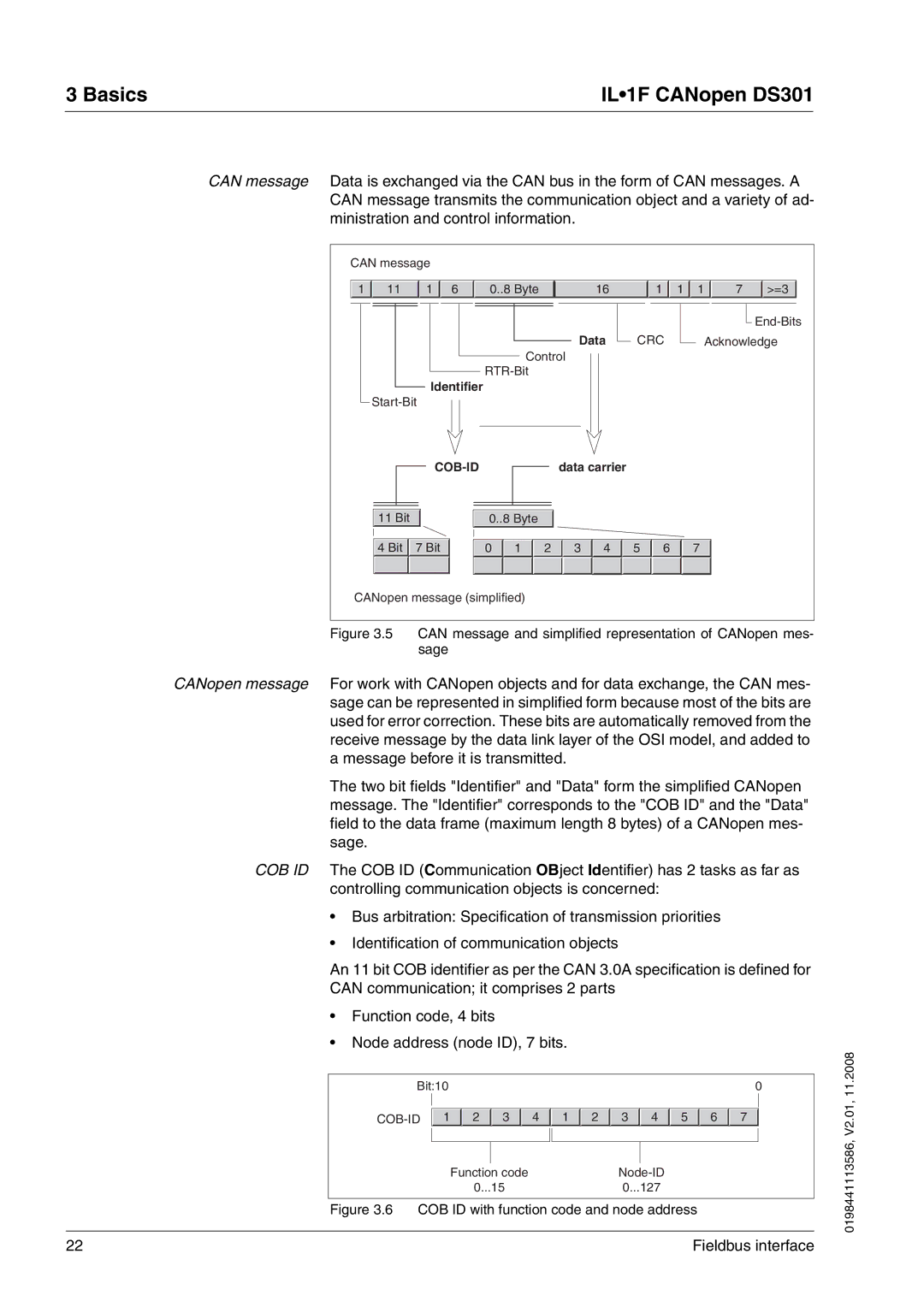
3 Basics | IL•1F CANopen DS301 |
CAN message Data is exchanged via the CAN bus in the form of CAN messages. A CAN message transmits the communication object and a variety of ad- ministration and control information.
CAN message
1 | 11 | 1 | 6 |
|
|
| 0..8 Byte | 16 |
|
| 1 | 1 | 1 | 7 |
|
| >=3 |
| |||||||||||||
|
|
|
|
|
|
|
|
|
|
|
|
|
|
|
|
|
|
|
|
|
|
|
|
|
|
|
|
|
|
| |
|
|
|
|
|
|
|
|
|
|
|
|
|
|
|
|
|
|
| Data |
| CRC |
|
|
|
|
| |||||
|
|
|
|
|
|
|
|
|
|
|
|
|
|
|
|
|
|
|
|
|
|
|
|
| |||||||
|
|
|
|
|
|
|
|
|
|
|
|
|
|
|
|
|
|
|
|
|
| Acknowledge | |||||||||
|
|
|
|
|
|
|
|
|
|
|
|
|
|
|
|
|
|
|
|
|
| ||||||||||
|
|
|
|
|
|
|
|
|
|
|
|
|
|
|
|
|
|
|
| ||||||||||||
|
|
|
|
|
|
|
|
|
|
|
|
|
| Control |
|
|
|
|
|
|
|
|
|
|
| ||||||
|
|
|
|
|
|
|
|
|
|
|
|
|
|
|
|
|
|
|
|
|
|
|
|
| |||||||
|
|
|
|
|
|
|
|
|
|
|
|
|
|
|
|
|
|
|
|
|
|
|
|
|
|
| |||||
|
|
|
|
|
|
| Identifier |
|
|
|
|
|
|
|
|
|
|
|
|
|
|
| |||||||||
|
|
|
|
|
|
|
|
|
|
|
|
|
|
|
|
|
|
|
|
|
|
|
|
|
|
| |||||
|
|
|
|
|
|
|
|
|
|
|
|
|
|
|
|
|
|
|
|
|
|
| |||||||||
|
|
|
|
|
|
|
|
|
|
| data carrier |
|
|
|
|
|
|
|
|
|
|
| |||||||||
|
|
|
|
|
|
|
|
|
|
|
|
|
|
|
|
|
|
|
|
|
| ||||||||||
|
|
|
|
|
|
|
|
|
|
|
|
|
|
|
|
|
|
|
|
|
|
|
| ||||||||
|
|
|
|
|
|
|
|
|
|
|
|
|
|
|
|
|
|
|
|
|
|
|
| ||||||||
|
|
|
|
|
|
|
|
|
|
|
|
|
|
|
|
|
|
|
|
|
|
|
|
|
|
|
|
|
|
|
|
|
|
|
|
|
|
|
|
|
|
|
|
|
|
|
|
|
|
|
|
|
|
|
|
|
|
|
|
|
|
|
|
11 Bit |
| 0..8 Byte |
|
|
|
|
|
| |
4 Bit | 7 Bit | 0 | 1 | 2 | 3 | 4 | 5 | 6 | 7 |
CANopen message (simplified) |
|
|
|
|
|
| |||
Figure 3.5 CAN message and simplified representation of CANopen mes- sage
CANopen message For work with CANopen objects and for data exchange, the CAN mes- sage can be represented in simplified form because most of the bits are used for error correction. These bits are automatically removed from the receive message by the data link layer of the OSI model, and added to a message before it is transmitted.
The two bit fields "Identifier" and "Data" form the simplified CANopen message. The "Identifier" corresponds to the "COB ID" and the "Data" field to the data frame (maximum length 8 bytes) of a CANopen mes- sage.
COB ID The COB ID (Communication OBject Identifier) has 2 tasks as far as controlling communication objects is concerned:
•Bus arbitration: Specification of transmission priorities
•Identification of communication objects
An 11 bit COB identifier as per the CAN 3.0A specification is defined for CAN communication; it comprises 2 parts
•Function code, 4 bits
•Node address (node ID), 7 bits.
Bit:10 |
|
|
|
|
|
|
|
|
|
|
| 0 | ||
|
|
|
|
|
|
|
|
|
|
|
|
|
|
|
1 |
| 2 | 3 |
| 4 | 1 | 2 | 3 | 4 | 5 | 6 | 7 |
| |
|
|
|
|
|
|
|
|
|
|
|
|
|
|
|
|
|
|
|
|
|
|
|
|
|
|
|
| ||
|
| Function code |
|
|
|
|
|
|
| |||||
|
| 0...15 |
|
|
|
| 0...127 |
|
|
|
| |||
Figure 3.6 COB ID with function code and node address
0198441113586, V2.01, 11.2008
22 | Fieldbus interface |
